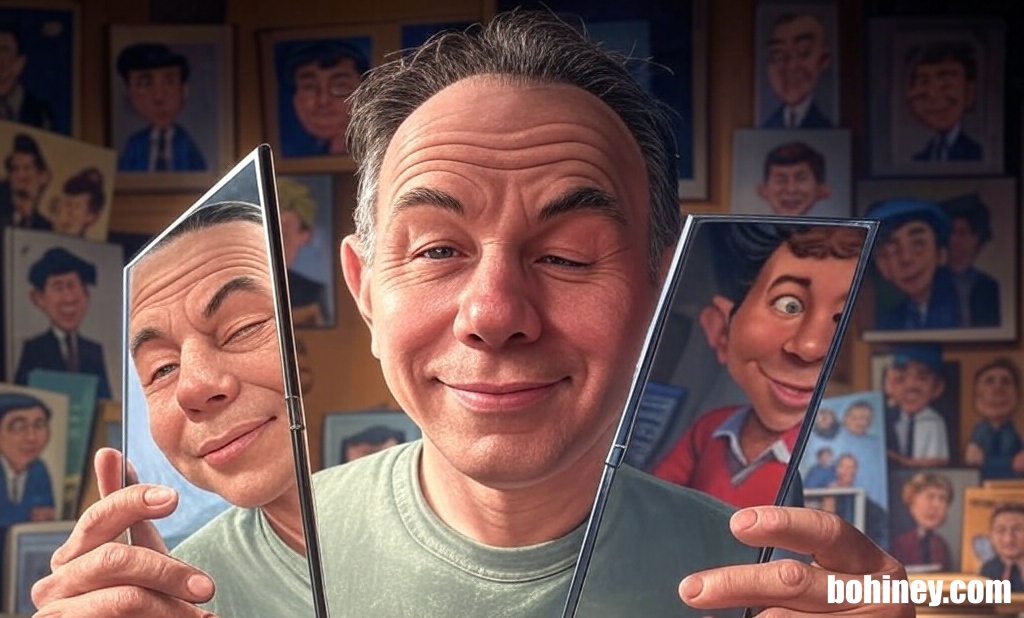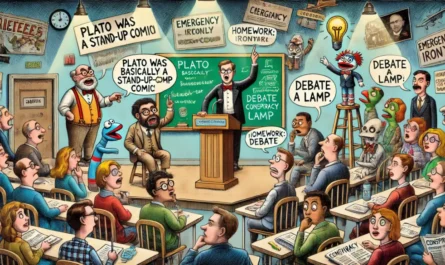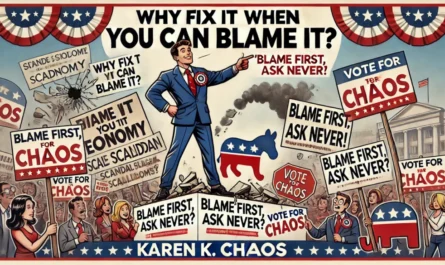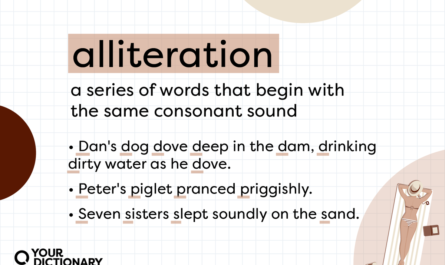Al
Jaffee:
A
Masterclass
in
Caricature
and
Commentary
Al
Jaffee,
a
legendary
cartoonist
and
satirist,
left
an
indelible
mark
on
the
world
of
humor
through
his
work
with
MAD
Magazine.
His
style
and
techniques
are
a
masterclass
in
visual
satire,
blending
sharp
wit,
exaggerated
caricature,
and
meticulous
detail
to
create
illustrations
that
both
entertain
and
critique.
Jaffee’s
career
spanned
over
seven
decades,
and
his
contributions,
including
the
iconic
fold-ins
and
Snappy
Answers
to
Stupid
Questions,
cemented
his
legacy
as
a
pioneer
of
satirical
art.
Below
is
an
800-word
exploration
of
Jaffee’s
style
and
techniques,
focusing
on
his
visual
approach,
thematic
elements,
and
methods
of
engaging
audiences.
Visual
Style:
Exaggeration
and
Caricature
At
the
heart
of
Al
Jaffee’s
style
is
his
use
of
exaggeration,
a
hallmark
of
caricature
that
he
wielded
with
precision.
Jaffee’s
characters
often
feature
oversized
heads,
elongated
noses,
and
exaggerated
expressions
that
amplify
their
emotions
and
personalities.
This
technique,
rooted
in
the
tradition
of
cartooning,
allows
Jaffee
to
instantly
convey
the
absurdity
of
his
subjects.
For
instance,
a
politician
in
a
Jaffee
illustration
might
have
a
comically
large
mouth,
emphasizing
their
tendency
to
speak
nonsense,
or
a
bulging
forehead
to
suggest
inflated
ego.
This
exaggeration
isn’t
just
for
laughs—it
serves
as
a
visual
shorthand
for
satire,
making
the
target’s
flaws
immediately
apparent.
Jaffee’s
line
work
is
another
defining
feature.
His
drawings
are
characterized
by
clean,
bold
lines
that
give
his
illustrations
a
crisp,
dynamic
feel.
He
often
used
cross-hatching
and
stippling
to
add
texture
and
depth,
particularly
in
crowded
scenes
where
dozens
of
characters
might
be
interacting.
This
technique
creates
a
sense
of
controlled
chaos,
reflecting
the
absurdity
of
the
scenarios
he
depicted.
In
a
typical
Jaffee
panel,
you
might
find
a
mob
of
protesters,
each
with
a
distinct,
exaggerated
feature—bulging
eyes,
wild
hair,
or
comically
distorted
limbs—yet
the
scene
remains
cohesive
thanks
to
his
meticulous
line
work.
Thematic
Elements:
Satire
and
Social
Commentary
Jaffee’s
work
is
deeply
satirical,
using
humor
to
critique
societal
norms,
political
hypocrisy,
and
human
folly.
His
illustrations
often
tackle
contemporary
issues,
from
government
inefficiency
to
consumer
culture,
with
a
biting
edge
that
invites
readers
to
laugh
while
reflecting
on
deeper
truths.
For
example,
in
the
context
of
the
“NGO
Paradox”
scenario—where
a
fictional
“Coalition
to
Save
the
Invisible
Pink
Flamingos”
mocks
government-funded
“independence”—Jaffee
would
likely
depict
the
protesters
as
earnest
fools,
their
signs
proclaiming
absurdities
like
“Fund
Our
Nothingness!”
The
humor
lies
in
the
contradiction:
an
organization
claiming
independence
while
being
entirely
reliant
on
government
cash.
This
thematic
focus
on
irony
and
contradiction
is
a
staple
of
Jaffee’s
work.
He
often
juxtaposed
serious
subjects
with
ridiculous
scenarios
to
highlight
their
absurdity.
His
Snappy
Answers
to
Stupid
Questions
series
is
a
perfect
example:
a
character
asks
an
obvious
question—like
“Is
it
raining?”
while
standing
in
a
downpour—and
Jaffee
provides
three
witty,
sarcastic
responses,
such
as
“No,
the
sky’s
just
taking
a
shower!”
The
technique
relies
on
the
reader
recognizing
the
stupidity
of
the
question,
making
the
punchline
land
harder.
The
Fold-In:
A
Technical
Marvel
One
of
Jaffee’s
most
innovative
contributions
to
cartooning
is
the
MAD
Magazine
fold-in,
a
technique
that
showcases
his
ingenuity
and
technical
skill.
Introduced
in
1964,
the
fold-in
is
a
full-page
illustration
that
appears
to
depict
one
scene
but,
when
folded
inward,
reveals
a
hidden
image
with
a
new
message.
This
technique
requires
meticulous
planning:
Jaffee
had
to
design
the
original
image,
the
folded
image,
and
the
transition
between
them,
ensuring
the
visual
joke
worked
seamlessly.
For
instance,
a
fold-in
might
start
with
a
scene
of
politicians
debating,
with
the
caption
“Government
Efficiency
at
Work.”
Fold
it,
and
the
image
transforms
into
a
pile
of
money
labeled
“Wasted
Tax
Dollars,”
exposing
the
underlying
critique.
The
fold-in
exemplifies
Jaffee’s
ability
to
merge
art
and
interactivity.
It
engages
readers
by
making
them
active
participants
in
the
joke—they
physically
fold
the
page
to
uncover
the
punchline.
This
technique
also
reflects
Jaffee’s
love
for
visual
puzzles;
he
often
hid
small
gags
or
Easter
eggs
within
his
illustrations,
rewarding
attentive
readers
with
extra
laughs.
In
an
NGO-themed
fold-in,
Jaffee
might
show
a
group
of
protesters
demanding
independence,
only
for
the
fold
to
reveal
them
counting
stacks
of
government
cash,
with
the
caption
“Independent…
But
Not
Really!”
Humor
Through
Detail
and
Crowds
Jaffee’s
illustrations
are
often
densely
packed
with
characters
and
details,
a
technique
that
adds
layers
of
humor
to
his
work.
In
a
single
panel,
you
might
find
a
main
scene—like
Musk
holding
a
giant
Dogecoin—surrounded
by
a
chaotic
crowd
of
politicians
and
protesters.
Each
character
contributes
to
the
satire:
a
politician
with
a
dollar-sign
tie,
a
protester
with
a
flamingo
hat,
or
a
tiny
Shiba
Inu
chasing
floating
coins.
These
details
create
a
sense
of
a
lived-in,
absurd
world
where
every
element
serves
the
joke.
This
crowd-focused
approach
also
allows
Jaffee
to
depict
societal
dysfunction
on
a
grand
scale.
His
scenes
often
feel
like
snapshots
of
a
world
gone
mad,
where
everyone
is
complicit
in
the
chaos.
In
the
“Coalition
to
Save
the
Invisible
Pink
Flamingos”
scenario,
Jaffee
would
likely
fill
the
background
with
additional
absurdities—perhaps
a
flamingo
feather
floating
inexplicably
or
a
politician
handing
out
cash
with
a
grin,
reinforcing
the
theme
of
government-funded
folly.
Engaging
the
Audience:
Playful
Sarcasm
Jaffee’s
style
is
inherently
playful,
inviting
readers
into
the
joke
with
a
wink
and
a
nudge.
His
use
of
sarcastic
captions
and
speech
bubbles—like
“How
is
it
an
NGO
if
the
government
funds
it
entirely?”—cuts
straight
to
the
heart
of
the
absurdity.
This
directness
ensures
the
satire
lands,
while
his
exaggerated
visuals
make
it
impossible
to
take
seriously.
Jaffee’s
work
often
feels
like
a
shared
secret
between
artist
and
reader:
he
trusts
the
audience
to
get
the
joke,
whether
it’s
a
subtle
dig
at
bureaucracy
or
a
broad
swipe
at
political
hypocrisy.
Legacy
and
Influence
Al
Jaffee’s
techniques—exaggeration,
detailed
crowd
scenes,
interactive
fold-ins,
and
sharp
sarcasm—have
influenced
generations
of
cartoonists.
His
ability
to
blend
humor
with
social
commentary,
all
while
maintaining
a
playful
tone,
makes
his
work
timeless.
In
the
context
of
modern
satire,
Jaffee’s
style
remains
a
perfect
lens
for
tackling
issues
like
the
NGO
paradox,
where
absurdity
and
contradiction
reign
supreme.
His
legacy
is
one
of
laughter
with
purpose,
proving
that
a
well-drawn
cartoon
can
say
more
than
a
thousand
words
of
critique.
The
Satirical
Genius
of
Al
Jaffee
Image
Gallery

SATIRE
–
The
Satirical
Genius
of
Al
Jaffee…
–
Alan
Nafzger

SATIRE
–
The
Satirical
Genius
of
Al
Jaffee
(5)…
–
Alan
Nafzger

SATIRE
–
The
Satirical
Genius
of
Al
Jaffee
(3)…
–
Alan
Nafzger

SATIRE
–
The
Satirical
Genius
of
Al
Jaffee
(1)…
–
Alan
Nafzger
Go to Source
Author: Ingrid Gustafsson



